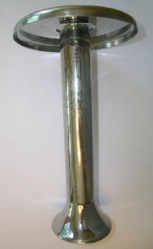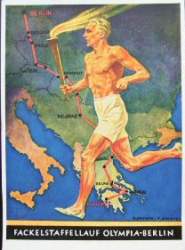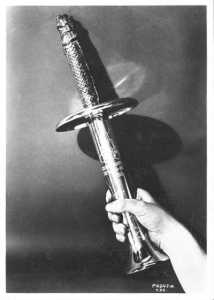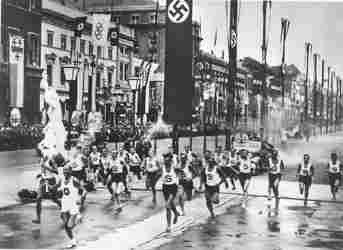Torch and Torch Relay
|
The Olympic Fire
The most significant and striking of the ceremonial aspects connected with the Olympic Games is the Olympic Fire. Ignited during the opening ceremony, it burns day and night at the Olympic Stadium and other scenes of competition during the period of the Games. Only when the Olympic Flag is lowered at the end of the closing ceremony is the Fire extinguished. At the Olympic Games of 1928 Amsterdam and at the Los Angeles Festival in 1932 the Olympic Fire burned at the top of a pillar extending above the Stadium. The Americans utlized natural gas as fuel, this being obtained from wells in the immediate vicinity of the centres of competition. 1928 1932 1934 |

|
 |
| Description: | Route of torch run from Olympia to Berlin on shaft, legend on top in German: "Organisationskomitee für die XI. Olympiade Berlin 1936". |
|---|---|
| Material: | Nirosta Steel; |
| Fuel: | Magnesium flares; |
| Torch measure: | Lenght: 27 cm Weight: 450 gr |
| Torches total: | 3,840 |
| Design by: | Walter Lemcke, Peter Wolf |
| Manufacturer: | Friedrich Krupp AG |
| Date of the torch relay: | 20. Juli - 1. August 1936 |
| Duration: | 12 days |
| Numbers of runners: | 3,331 |
| Distance total: | 3.187 km |
| Name of the last runner: | Fritz Schilgen |
|
|
|
The Torch Relay Run from Olympia to Berlin Through the organization of the Olympic Torch Relay Run the Eleventh Olympic Games were introduced in a manner which in its impressiveness and significance could scarcely have been surpassed. For the first time in the history of the modern Games the Olympic Fire was ignited with a flame borne directly from the sanctuary of the ancient Festival. At its meeting in May, 1934 in Athens, the International Olympic Committee approved the proposal of the Secretary-General of the Organizing Committee to have this flame carried by relay runners from Olympia to Berlin. The National Olympic Committee of Greece, Bulgaria, Yugoslavia, Hungary, Austria, Czechoslovakia and Germany - the seven countries through which the flame would be carried - were in complete favour of this projekt and gladly cooperated in preparing for it. 
The entire course was dividet into stretches of 1,000 metres, and each of these was covered by a runner, who then passed the Olympic Fire to his successor. The Organizing Committee estimated that an average time of 5 minutes would be required for each 1,000 metres, and the National Olympic Commttees of the fifferent countries were authorized to make special provisions such as increasing the stretches in thinly populated sections or allowing more times for traversing difficult districts. 
None of the torches on the market at that time answered the requirements. Although a new torch would be ignited by each runner, the fact had to be taken into consideration that in case of an emergency a runner might be required to carry the same torch over a double stretch. It was therefore necessary to divise torches which would burn 10 minutes and which would not be affected by heat, rain, storms or falls. A magnesium torch was created which contained two fuses so that even should the burning part fall from the torch, the fuses would continue to glow and re-ignite it. The torches were encased in a reinforced covering in order to give them the required durability. The length of the torch including a cone-formed grip was 27.7 inches, its diameter 1.15 inches and its weight 1.5 pounds. The top of the torch consisted of a special inflammable substance so that it could be rapidly ignited when the flame was transferred from runner to runner. |
| Country | Date | Distance | Runners | Torches |
|---|---|---|---|---|
| Greece | 20.07. - 25.07.1936 | 1,108 km | 1,108 | 1,108 |
| Bulgaria | 25.07. - 26.07.1936 | 238 km | 238 | 238 |
| Yugoslavia | 26.07. - 28.07.1936 | 575 km | 575 | 575 |
| Hungary | 28.07. - 29.07.1936 | 386 km | 386 | 386 |
| Austria | 29.07. - 30.07.1936 | 219 km | 219 | 219 |
| Czechoslovakia | 30.07. - 31.07.1936 | 282 km | 282 | 282 |
| Germany | 31.07. - 01.08.1936 | 267 km | 267 | 267 |
More details see Official Report Berlin 1936, vol. 1, pages 512 - 536
The Organizing Committee presented a specially designed holder to each participant as a souvenir of the Torch Relay Run, this being designed by the sculptor who created the Olympic Bell, Herr Lemcke. The route over which the Olympic Fire was carried from Olympia to Berlin was engraved on the grip of the holder, and the Krupp Firm in Essen generously contributed a sufficient number of these in polished, stainless steel. The words, "In gratitude to the bearer," were also engraved on the holder.
Its entire length was 10.4 inches and its weight 1 pound. The torches, which contained a wooden grip at the lower end, could be fitted firmly into these holders. The plate at the tip of the holder protected the runner from flames which might be whipped by the wind. Holders and a special certificate for each runner and organizing manager were despatched to the National Olympic Committee in March, 1936.

A special commemoration diploma was designed for the participants in the Olympic torch relay run from Olympia to Berlin, this being created by the Berlin painter and graphic artist, Hönig. His design revealed the fire altar and Olympic rings in yellow-brown tones with the eagle as a background and the Olympic Bell in colourless embossing. Each certificate contained the facsimile signature of the President of the Organizing Committee and was inscribed with the name of the participant. The relationship between this torch relay run of the modern Olympic Games and the ancient festival was expressed in the brochures published in connection with this event, these being designed in an especially artistic manner. The reproduction of a Hellenic relief from the Palazzo Colonna in Rome was utilized for the cover, this having been generously permitted by the Prince of Colonna. The relief, which depicts two Erotes as torch bearers, was used by the creator of the Olympic Bell, Walter E. Lemcke, as the basis of his design.
(Source document: Official Report 1936, Vol. 1, page 126, 512)